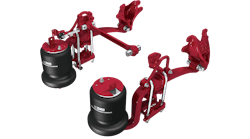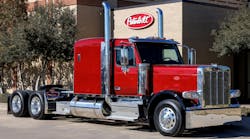The Price of diesel fuel rose well above $4 a gallon in 2008, a significant increase over 2007. With predictions of even larger increases for refined fuels in the future, the value of bulk shipments are ballooning beyond what most transporters ever imagined.
For petroleum transport fleet owners, rising prices can mean more questions from customers about the accuracy of custody transfers, as well as uneasiness about theft. Concern about the security of petroleum shipments is growing.
Some incidents worth noting over the past year include one loaded tanker stolen from a terminal in Houston, Texas; an organized siphoning scheme uncovered in Georgia; and a tanker in Baltimore, Maryland, with 7,100 gallons of diesel fuel hijacked at gunpoint as the driver was re-fueling. That tanker later was found empty and abandoned southwest of Washington DC.
The problem is not unique to the United States. In Germany last year, three tankers were stolen from a terminal and later found empty. The loss in that incidence totaled 90,000 liters (23,775 gallons).
No industry organization or government agency tracks the amount of petroleum lost or unaccounted for annually, but one corporate executive estimates that, on average, two percent of all shipments never arrive at their assigned destination. There is no doubt that risk increases relative to rising prices. While circumstances haven't reached the point yet where bulk haulers in the petroleum industry are the equivalent of what armored car drivers are to banks, it is safe to assume that there is, and always will be, some element of theft-risk associated with hauling fuel.
Rising values of tank truck fuel shipments have led to more sophisticated and more accurate theft-detection systems to help fleet operators stay one step ahead of the crooks.
“Peace of mind is one thing fleet owners like,” says Kevin Stump, Tank Truck Systems product manager for FMC Technologies in the United Kingdom. “As the price of oil rises, there seems to be more skittishness, whether it is stated or not, that an existing security plan may not be sufficient.”
Peace of mind is appealing to Eric Pate, fleet manager for North Carolina-based Waccamaw Transport Inc, but theft is not top of mind. “As the price of product had increased, we've seen an increase in the number of customers questioning whether they received the full amount,” he says. “If a customer says we shorted them a hundred gallons of diesel fuel, right now that's $400. If they want to withhold $400 from payment, that's a problem.”
Waccamaw Transport uses a GPS (global positioning satellite) system to provide customers with a printout of the location of the loading terminal, the route the truck took, the location of the delivery, and then the location of the next stop to verify that no stops were made before or after that customer's delivery.
“We do that because if the customer has a problem, we want them to know their problem is with the terminal and not with us,” says Pate.
Waccamaw runs five compartments in each of their 56 tank trailers and typically operates within a 150-mile radius of petroleum terminals, serving both urban and rural areas in the eastern Carolinas and Virginia.
Electronic seals
A new “sealed-parcel-delivery” system called MultiSeal is helping fleet owners gain peace of mind and resolve customer concerns. Developed by FMC Technologies, MultiSeal has been available in Europe for the past 10 years and is being more widely used as petroleum prices rise. The MultiSeal system controls volume deposited into a tank truck compartment and “seals” that compartment electronically. The electronic seal remains unbroken until delivery is made when the compartment is unsealed and completely emptied. This system ensures that the quantity delivered is the same as the quantity loaded.
MultiSeal accepts bulk tankers to be divided into multiple compartments (for instance, one compartment with 6,500 liters (1,717 gallons) of fuel oil, a second compartment with 10,000 liters (2,641 gallons) of unleaded gasoline, and so on), each sealed, monitored, and verified in the MultiSeal computer. Each truck and each compartment can be monitored remotely via a GPRS (general packet radio service) device as simple to operate as a cell phone.
Vapor regulations in the early 1990s helped drive electronic systems in Europe because they eliminated the need to open the tanker domelid and the use of dipsticks.
Those regulations, along with the ability to monitor all operations simultaneously, in real time, is one reason ConocoPhillips adopted the FMC Technologies sealed-parcel-delivery system for its 80 branded tankers in Germany.
Before adopting sealed-parcel-delivery, ConocoPhillips used multiple meters to measure the quantities of diesel and gasoline filled in separate compartments for multiple-site delivery. The standard-size ConocoPhillips tanker has a 43,000-liter (11,359-gallon) capacity and up to four compartments ranging in size from 3,000 to 18,000 liters (792 to 4,755 gallons). Today the meters are gone from the trucks; replaced with the electronic sealing system.
“This system lets me see everything a driver is doing without being overwhelmed with paper,” says Karl C Strack, ConocoPhillips' senior advisor for road transportation. “We have better tracking of our haulers and transport companies because the electronic sealing systems are connected to headquarters. I can track everything from my office.”
Aiding ConocoPhillips' decision to adopt MultiSeal was the company's participation over the past decade in a five-company cooperative relationship with Shell, as well as with three equipment and technology companies, to establish electronic monitoring standards. The cooperative is called E7. Based on E7 standards, the MultiSeal system is one reason ConocoPhillips has had the best stop-loss system in the business for the past five years.
“In the late 90s when electronic sealing systems were introduced we ran a one-year test on the first truck before the approvals came through,” says Strack. “The results showed MultiSeal helped us track deliveries more accurately, save time delivering each stop, and account for moisture and other variables that can affect volume. We're after lighter trucks for better efficiency and that's one reason we like MultiSeal.”
Equipping the ConocoPhillips trucks with MultiSeal is a running process. “We will continue to equip trucks with MultiSeal over the coming years, as costs allows,” says Strack. “I feel that our haulers will also.”
ABS Bonifer Transport in Offenbach, Germany, has more than 100 tankers equipped with MultiSeal and has used the system for the past 10 years.
“Prior to sealed-parcel-delivery we used meters, or in some cases, nothing at all,” says President Andreas Bonifer. “We were looking for a system that would help us do more with less staff and that would allow us to be more than just a delivery service, to be a logistics partner, if you will, to our customer.”
Bonifer tested MultiSeal for six months before adapting his entire fleet. The MultiSeal system was installed on the Bonifer fleet over a 15-month period.
“We found that we were able to save time because MultiSeal allowed us to discharge accurate volumes faster than before,” he says. “There was no guessing about volume and no time lost trying to deliver exact amounts.”
After reviewing literature about the MultiSeal system fleet manager Pate sees how the system can benefit the US transport industry. “I love the fact that it shows a clear statement for the full compartment and then another for the empty compartment,” he says. “That's the kind of proof I'd like to give customers.”
FMC Technologies does not yet sell MultiSeal in the US market but may in the near future. One major UK Oil Company indicated that with the design changes they could make to their tanker specification by fitting MultiSeal, pay back time would be around one and a half years.
Security key
Accurate measurement and logging is just one aspect of tanker security. Personnel management is another. The vast majority of gas thefts from tank trucks occur when employees either leave voluntarily, or are terminated, from a bulk transport company. Why?
Typically drivers are issued a loading rack identification number, or card, by their trucking company. This number provides the authorizing credential that allows drivers to load fuel into a truck. A study earlier this year by the New England Fuel Institute found that many transportation shipping facilities, including a handful of petroleum refineries and terminals not included under the federal Transportation Worker Identity Credential (TWIC), are requiring drivers to present TWIC cards in order to get beyond the facility gate. But unless bulk carriers recover all authorizing credentials when drivers cease employment, or unless the identification code is changed regularly at the terminal, product can be at risk of theft and/or tampering.
Identifying proper separation policies, and then following them each time an employee leaves the company, is something some bulk transporters, especially smaller carriers, may not see as efficient use of time. In the long run however, following strict separation procedures is easier than dealing with lost product, stolen tankers, or unhappy customers.








